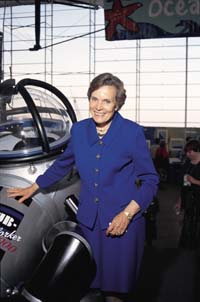|
|
|
The Power to Change the World
Marine research pioneer Sylvia Earle opened her keynote address at this year's user conference by observing, "Esri is everywhere, GIS is everywhere, and they need to be at this critical, pivotal time in human history."  She described the current threats to the marine environment and the importance of GIS in studying and saving this "cornerstone to our existence." She described the current threats to the marine environment and the importance of GIS in studying and saving this "cornerstone to our existence."
Earle, a marine biologist who holds a doctorate from Duke University, was named one of Time magazine's Heroes of the Planet in 1998. Sometimes known as "Her Deepness," Earle was one of the first to research marine ecosystems. She has led more than 50 expeditions for a total of 6,000 hours spent underwater and holds numerous diving records. She is also the former chief scientist for the National Oceanic and Atmospheric Administration (NOAA). In addition, she has written three books including her newest, Wild Oceans, and has authored more than 100 scientific and popular publications.
In her current role as explorer-in-residence at the National Geographic Society she is the project director of Sustainable Seas Expeditions (SSE). Earle founded and chairs Deep Ocean Exploration and Research Inc., cofounded Deep Ocean Engineering, Inc., and is a spokesperson for SeaWeb, a conservation initiative of the Pew Charitable Trusts.
During her address, Earle cautioned, "The sea is not limitless. There is a limit to what the sea can endure." She observed that we are only now really starting to understand that water is "the single nonnegotiable thing in the environment." Her years of research and exploration have given her a deep appreciation of the beauty and complexity of the undersea world. The deterioration she has seen in those years has made her a vigorous proponent of protecting oceans and developing technologies to explore them.
To this end, she has been an advocate for the National Marine Sanctuaries, 12 areas of the marine environment of special significance designated for protection and management by NOAA. Earle describes marine sanctuaries as "one of the nation's best ideas and best kept secrets."  A $5 million grant was awarded by the Goldman Fund in San Francisco to the National Geographic Society to explore the continental shelf of North America, particularly in these marine sanctuaries. NOAA has partnered with the National Geographic Society and donated $4 million in resources to the exploration project. A $5 million grant was awarded by the Goldman Fund in San Francisco to the National Geographic Society to explore the continental shelf of North America, particularly in these marine sanctuaries. NOAA has partnered with the National Geographic Society and donated $4 million in resources to the exploration project.
In connection with her work in studying marine sanctuaries, she has helped develop a small submersible called DeepWorker that is "so simple even a scientist can operate it." This transportable craft surrounds the operator with a one-atmosphere shell much like an astronaut in a space suit. The vehicle, which has up to 100 hours of life support, doesn't require operators to undergo a decompression period and is ideal for conducting research in the sanctuaries.
"Where does GIS come into all of this? Better to ask where GIS doesn't play a role in understanding the ocean," said Earle. Everything about marine ecosystems is geospatial in nature. Spatial, temporal, and functional relationships among creatures, environments, and human perturbations must be recorded and integrated to arrive at meaningful solutions. In the last decade, improvements in GIS tools have provided a "quantum leap in our ability to understand and manage marine ecosystems." Foremost among these new tools is three-dimensional GIS data modeling.
SSE uses the real-time navigation and GPS data integration capabilities of GIS to track submersibles and position support ships. GIS gives SSE an improved basis for planning and conducting future expeditions as well as enhancing the ability to interpret, communicate, and disseminate expedition and research results. Monitoring programs that assess marine sanctuary ecosystem health will also use GIS. Numerous databases created by other scientists studying the marine environment will be integrated using GIS.
Earle concluded the address by observing that GIS has made this a very exciting time to study the ocean. "Now suddenly so much I can see as never before in context. It's that kind of 'ah-ha' breakthrough that these new integrating data systems allow. I can't wait to see what's going to happen as we begin to work together. I mean, right here in this room there is the power to change the world--the way we look at the world--the way the world goes forward henceforth--if we just use the technologies, join together with our minds and our hearts and our commitment to make a difference."
|
